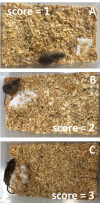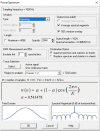Hippocampal Unicellular Recordings and Hippocampal-dependent Innate Behaviors in an Adolescent Mouse Model of Alzheimer's disease
- PMID: 33654753
- PMCID: PMC7842348
- DOI: 10.21769/BioProtoc.3529
Hippocampal Unicellular Recordings and Hippocampal-dependent Innate Behaviors in an Adolescent Mouse Model of Alzheimer's disease
Abstract
Transgenic mice have been used to make valuable contributions to the field of neuroscience and model neurological diseases. The simultaneous functional analysis of hippocampal cell activity combined with hippocampal dependent innate task evaluations provides a reliable experimental approach to detect fine changes during early phases of neurodegeneration. To this aim, we used a merge of patch-clamp with two hippocampal innate behavior tasks. With this experimental approach, whole-cell recordings of CA1 pyramidal cells, combined with hippocampal-dependent innate behaviors, have been crucial for evaluating the early mechanism of neurodegeneration and its consequences. Here, we present our protocol for ex vivo whole-cell recordings of CA1 pyramidal cells and hippocampal dependent innate behaviors in an adolescent (p30) mice.
Keywords: Hippocampus; Innate behavior; Neurodegeneration; Patch-clamp; Pyramidal cells; Subthreshold oscillations and Alzheimer’s disease.
Copyright © 2020 The Authors; exclusive licensee Bio-protocol LLC.
Conflict of interest statement
Competing interestsThe authors declare no competing financial interests.
Figures














Similar articles
-
Early alterations in hippocampal perisomatic GABAergic synapses and network oscillations in a mouse model of Alzheimer's disease amyloidosis.PLoS One. 2019 Jan 15;14(1):e0209228. doi: 10.1371/journal.pone.0209228. eCollection 2019. PLoS One. 2019. PMID: 30645585 Free PMC article.
-
Activation of PLCβ1 enhances endocannabinoid mobilization to restore hippocampal spike-timing-dependent potentiation and contextual fear memory impaired by Alzheimer's amyloidosis.Alzheimers Res Ther. 2021 Oct 8;13(1):165. doi: 10.1186/s13195-021-00901-9. Alzheimers Res Ther. 2021. PMID: 34625112 Free PMC article.
-
Functional Alterations in the Olfactory Neuronal Circuit Occur before Hippocampal Plasticity Deficits in the P301S Mouse Model of Tauopathy: Implications for Early Diagnosis and Translational Research in Alzheimer's Disease.Int J Mol Sci. 2020 Jul 30;21(15):5431. doi: 10.3390/ijms21155431. Int J Mol Sci. 2020. PMID: 32751531 Free PMC article.
-
Excitatory Inputs Determine Phase-Locking Strength and Spike-Timing of CA1 Stratum Oriens/Alveus Parvalbumin and Somatostatin Interneurons during Intrinsically Generated Hippocampal Theta Rhythm.J Neurosci. 2016 Jun 22;36(25):6605-22. doi: 10.1523/JNEUROSCI.3951-13.2016. J Neurosci. 2016. PMID: 27335395 Free PMC article.
-
Reduction of Dendritic Inhibition in CA1 Pyramidal Neurons in Amyloidosis Models of Early Alzheimer's Disease.J Alzheimers Dis. 2020;78(3):951-964. doi: 10.3233/JAD-200527. J Alzheimers Dis. 2020. PMID: 33074225 Free PMC article.
Cited by
-
Circuitry and Synaptic Dysfunction in Alzheimer's Disease: A New Tau Hypothesis.Neural Plast. 2020 Sep 1;2020:2960343. doi: 10.1155/2020/2960343. eCollection 2020. Neural Plast. 2020. PMID: 32952546 Free PMC article. Review.
References
-
- Deacon R. M., Raley J. M., Perry V. H. and Rawlins J. N.(2001). Burrowing into prion disease. Neuroreport 12(9): 2053-2057. - PubMed
-
- Gjendal K., Ottesen J. L., Olsson I. A. S. and Sørensen D. B.(2019). Burrowing and nest building activity in mice after exposure to grid floor, isoflurane or ip injections. Physiol Behav 206: 59-66. - PubMed
-
- Ittner L. M., Ke Y. D., Delerue F., Bi M., Gladbach A., van Eersel J., Wolfing H., Chieng B. C., Christie M. J., Napier I. A., Eckert A., Staufenbiel M., Hardeman E. and Gotz J.(2010). Dendritic function of tau mediates amyloid-beta toxicity in Alzheimer's disease mouse models. Cell 142(3): 387-397. - PubMed
Grants and funding
LinkOut - more resources
Full Text Sources
Other Literature Sources
Miscellaneous

